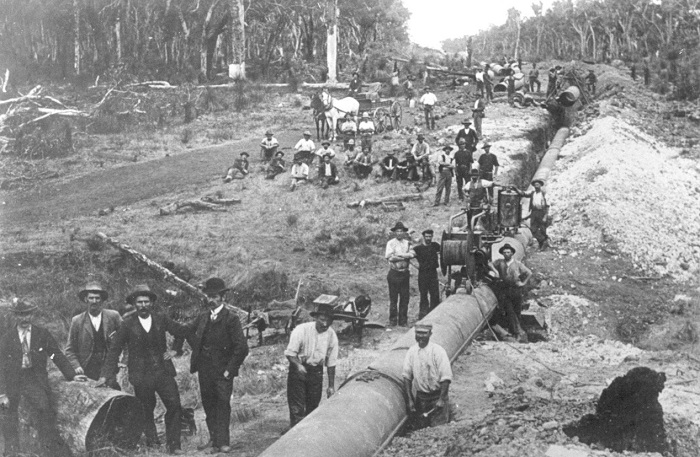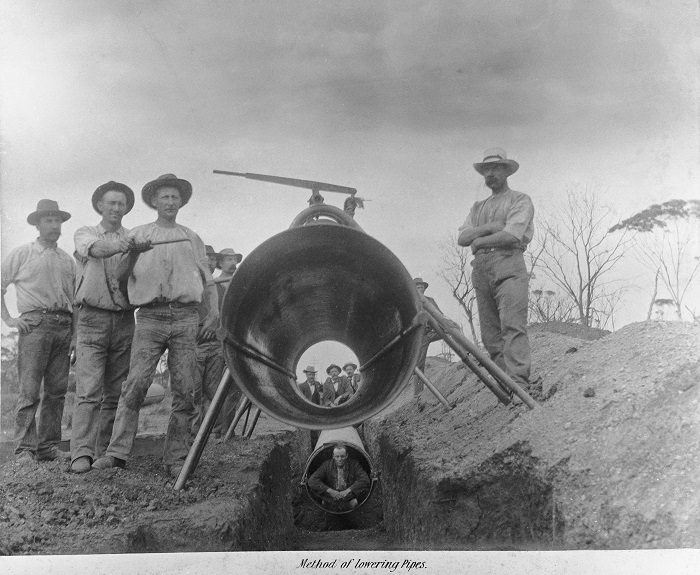Golden Pipeline heritage proposal open for public consultation

- Sections of Golden Pipeline to be gradually replaced with below-ground pipe over 50 years
- Essential pipeline upgrades needed to secure safe and reliable long-term water supply for the Goldfields
- Extensive plans to preserve CY O'Connor's iconic pipeline heritage and tourism value
- Proposal to continue ongoing pipe renewal works over many decades
- Supports population and economic growth in the Goldfields and Agricultural regions
Water Minister Dave Kelly today announced that a proposal to gradually remove old sections of the Goldfields Water Supply Scheme pipeline over the next 50 years, enabling more efficient operation and maintenance, was open for public consultation.
Essential long-term upgrades to the 118-year-old pipeline, commonly known as the Golden or Goldfields Pipeline, are required to secure safe and reliable water supply for the region into the future, as the above-ground pipe reaches the end of its service life.
Initially proposed in 2018, Water Corporation is seeking long-term approval to carry out the essential upgrades under the Commonwealth Environment Protection and Biodiversity Conservation Act 1999, as sections of the pipeline are progressively replaced with modern below-ground pipe over a 50-year period.
Extensive lengths of the above-ground pipeline will be retained for heritage, tourism and operational purposes, following planned community consultation.
Since opening in 1903, the majority of the original 566km pipeline - brainchild of Western Australia's first Engineer-in-Chief CY O'Connor - has been replaced, with all the pipework upgraded as part of a continuous cycle of maintenance and renewal.
Originally laid below ground, the pipeline was raised onto concrete blocks in the 1930s, so that leaks could be more readily identified and repaired.
The current above-ground pipeline bisects large tracts of private farmland, which fragments land, makes maintenance of the pipeline more complex and limits the public's ability to access and enjoy the heritage values of the pipeline.
Modern leak detection and materials technologies allow the pipeline to be laid below ground again, with performance, safety and security benefits, while also supporting population and economic growth in the Goldfields and Agricultural regions.
Following the public consultation, there will be further opportunities for public comment under Water Corporation's long-term heritage 'interpretation strategy' for the pipeline.
The proposal is open for public comment until Monday, October 25, 2021. Visit: http://yoursay.watercorporation.com.au/golden-pipeline
Comments attributed to Water Minister Dave Kelly:
"The McGowan Government and Water Corporation value the rich heritage of CY O'Connor's iconic Golden Pipeline and its significant contribution to the development of Western Australia.
"We are fully committed to preserving and celebrating the pipeline's historical legacy and tourism value.
"Under this proposal, significant sections of the pipeline will still be visible and Water Corporation will engage with the community, both now and in the future, to prioritise areas of above-ground pipe for preservation and ways to reuse the old pipe.
"This proposal seeks to implement a long-term co-ordinated plan to preserve the heritage value of the pipeline for future generations, rather than applying for permission to remove smaller sections of pipe on a piecemeal basis.
"Non-operational pipe degrades when taken out of service. Without this approval, Water Corporation would need to maintain both an operational and decommissioned pipeline into the future, at considerable additional cost to the taxpayer."
Comments attributed to Kalgoorlie MLA Ali Kent:
"While many people, particularly in the regions, understandably feel a strong connection to the Golden Pipeline, the current above-ground pipe is not the original with large sections having already been replaced over the past 118 years.
"The pipework has a finite life and these essential upgrades are necessary to ensure the continued safe and reliable supply of drinking water to the regions, as well as supporting future population and economic growth.
"Lots of the current pipeline will still be visible but re-sinking some sections underground frees up farmland and protects this vital pipeline from traffic collisions, bushfires and vandalism.
"I particularly commend Water Corporation's commitment to preserving sections of old pipeline for heritage and tourism benefit, so we can continue to celebrate CY O'Connor's engineering marvel for many years to come."
Minister's office - 6552 6100
Goldfields Water Supply Scheme ‘Golden Pipeline’ fact file
- Designed and built under the supervision of WA’s first Engineer-in-Chief, Charles Yelverton (CY) O’Connor, to supply fresh water to the arid Goldfields.
- Constructed between 1898 and 1903 to pump fresh water 566km east from Mundaring Weir to Mount Charlotte Reservoir, Kalgoorlie.
- Designed over eight separate sections to overcome the difficulty of pumping water uphill (390m) over such long distances. It included two main reservoirs, the main conduit of the pipeline, eight pumping stations, holding tanks and regulating tanks.
- Original pipes were made of 30-inch diameter steel and connected using a locking bar system instead of rivets. A coating of tar and bitumen protected the steel from corrosion.
- The 28 feet (8.5m) long pipes were manufactured in Perth from American and German steel with locking bars and joint rings shipped from England.
- Pipeline was built, where possible, alongside the route of the railway line to enable the pipes to be easily transported. The 60,000 pipes were laid underground to avoid temperature-related expansion and contraction issues.
- Officially opened at Mount Charlotte, Kalgoorlie, on 24 January 1903, then the longest freshwater pipeline in the world.
- In the 1930s, due to corrosion and leakage, the pipes were lined with concrete and re-laid above ground on concrete blocks. Due to political pressure amid the Great Depression, 64km of steel sections were replaced with karri wood pipes to support the timber industry and save costs but all were replaced by 1971 due to leakage, termite damage and dry rot.
- Original pumps at the eight pumping stations could deliver 5 million gallons (22.73 million litres) of water per day.
- The pipeline is one of the elements of the Goldfields Water Supply Scheme that was included on the National Heritage List in 2011, subject to the Environment Protection and Biodiversity Conservation Act 1999.
- In 2009, the scheme was recognised internationally by the American Society of Civil Engineers as an international Historic Civil Engineering Landmark.
Source: Extracts taken from the National Trust of Western Australia ‘The Golden Pipeline’ information sheets.

Constructed between 1898 and 1903, the 566km pipeline was originally laid below ground.

Original pipes were made of 30-inch diameter steel and connected using a locking bar system instead of rivets. A coating of tar and bitumen protected the steel from corrosion.